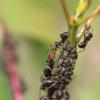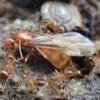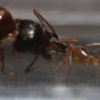I can't find the link at the moment, but one paper I found on a University site mentioned Temnothorax they believe may use glycerol and allows they to survive very cold temperatures like camponotus. They also noted they tended to have very high death rates, and Antwiki mentioned they are highly flexible nest/queen-wise (I posted this to the mirror of this post, hopefully @dspdrew will merge the treads and I'll delete this post as a dupe).
From antwiki.org:
"Nests are located in preformed cavities in structures found in the litter, e.g., in small sticks or nuts. Temnothorax curvispinosus is facultatively polydomous and their nesting arrangements vary with season. In the productive summer months, colonies can fragment and be arranged across numerous nest sites. These vary in queen number, from multiple queens to those that only have workers and brood."
"Queen number can vary by colony and season. New colonies are founded by pleoemetrosis and new queens are likely adopted into existing nests. The latter is evident from the presence within populations of both monogynous and polygonous nests. Reproductive queens contain 8 ovarioles.
Worker reproduction does occur with some male production possible from worker derived eggs. Reproductive workers contain 2 ovarioles.
New queens are produced in some queenless nests. These are presumed to be nests that are separated from a queenright nests or from a nest that had earlier lost its queen(s)."
Edited by noebl1, December 23 2016 - 8:05 AM.

















